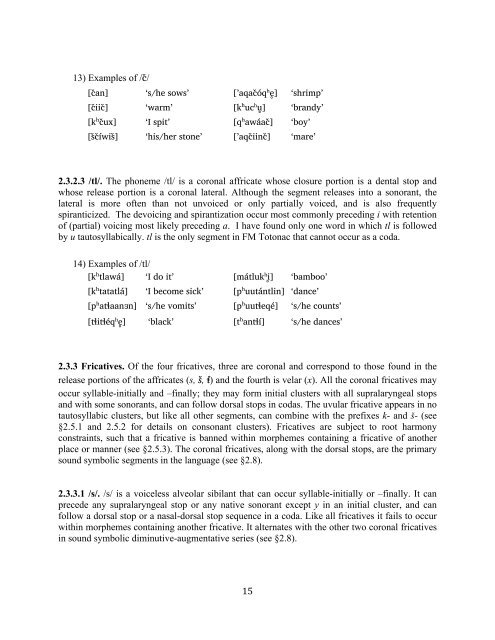The phonology and morphology of Filomeno Mata Totonac
The phonology and morphology of Filomeno Mata Totonac
The phonology and morphology of Filomeno Mata Totonac
Create successful ePaper yourself
Turn your PDF publications into a flip-book with our unique Google optimized e-Paper software.
13) Examples <strong>of</strong> /c"/<br />
[c"an] ‘s/he sows’ [’aqac"óq h e&] ‘shrimp’<br />
[c"iic"] ‘warm’ [k%uc h u&] ‘br<strong>and</strong>y’<br />
[k%c"ux] ‘I spit’ [q%awáac"] ‘boy’<br />
[s"c"íwis"] ‘his/her stone’ [’aqc"iinc"] ‘mare’<br />
2.3.2.3 /tl/. <strong>The</strong> phoneme /tl/ is a coronal affricate whose closure portion is a dental stop <strong>and</strong><br />
whose release portion is a coronal lateral. Although the segment releases into a sonorant, the<br />
lateral is more <strong>of</strong>ten than not unvoiced or only partially voiced, <strong>and</strong> is also frequently<br />
spiranticized. <strong>The</strong> devoicing <strong>and</strong> spirantization occur most commonly preceding i with retention<br />
<strong>of</strong> (partial) voicing most likely preceding a. I have found only one word in which tl is followed<br />
by u tautosyllabically. tl is the only segment in FM <strong>Totonac</strong> that cannot occur as a coda.<br />
14) Examples <strong>of</strong> /tl/<br />
[k%tlawá] ‘I do it’ [mátluk h i&] ‘bamboo’<br />
[k%tatatlá] ‘I become sick’ [p%uutántlin] ‘dance’<br />
[p%at#aanŒn] ‘s/he vomits’ [p%uut#eqé] ‘s/he counts’<br />
[t#it#éq h e&] ‘black’ [t%ant#í] ‘s/he dances’<br />
2.3.3 Fricatives. Of the four fricatives, three are coronal <strong>and</strong> correspond to those found in the<br />
release portions <strong>of</strong> the affricates (s, s%, ") <strong>and</strong> the fourth is velar (x). All the coronal fricatives may<br />
occur syllable-initially <strong>and</strong> –finally; they may form initial clusters with all supralaryngeal stops<br />
<strong>and</strong> with some sonorants, <strong>and</strong> can follow dorsal stops in codas. <strong>The</strong> uvular fricative appears in no<br />
tautosyllabic clusters, but like all other segments, can combine with the prefixes k- <strong>and</strong> #- (see<br />
§2.5.1 <strong>and</strong> 2.5.2 for details on consonant clusters). Fricatives are subject to root harmony<br />
constraints, such that a fricative is banned within morphemes containing a fricative <strong>of</strong> another<br />
place or manner (see §2.5.3). <strong>The</strong> coronal fricatives, along with the dorsal stops, are the primary<br />
sound symbolic segments in the language (see §2.8).<br />
2.3.3.1 /s/. /s/ is a voiceless alveolar sibilant that can occur syllable-initially or –finally. It can<br />
precede any supralaryngeal stop or any native sonorant except y in an initial cluster, <strong>and</strong> can<br />
follow a dorsal stop or a nasal-dorsal stop sequence in a coda. Like all fricatives it fails to occur<br />
within morphemes containing another fricative. It alternates with the other two coronal fricatives<br />
in sound symbolic diminutive-augmentative series (see §2.8).<br />
! ")!

















